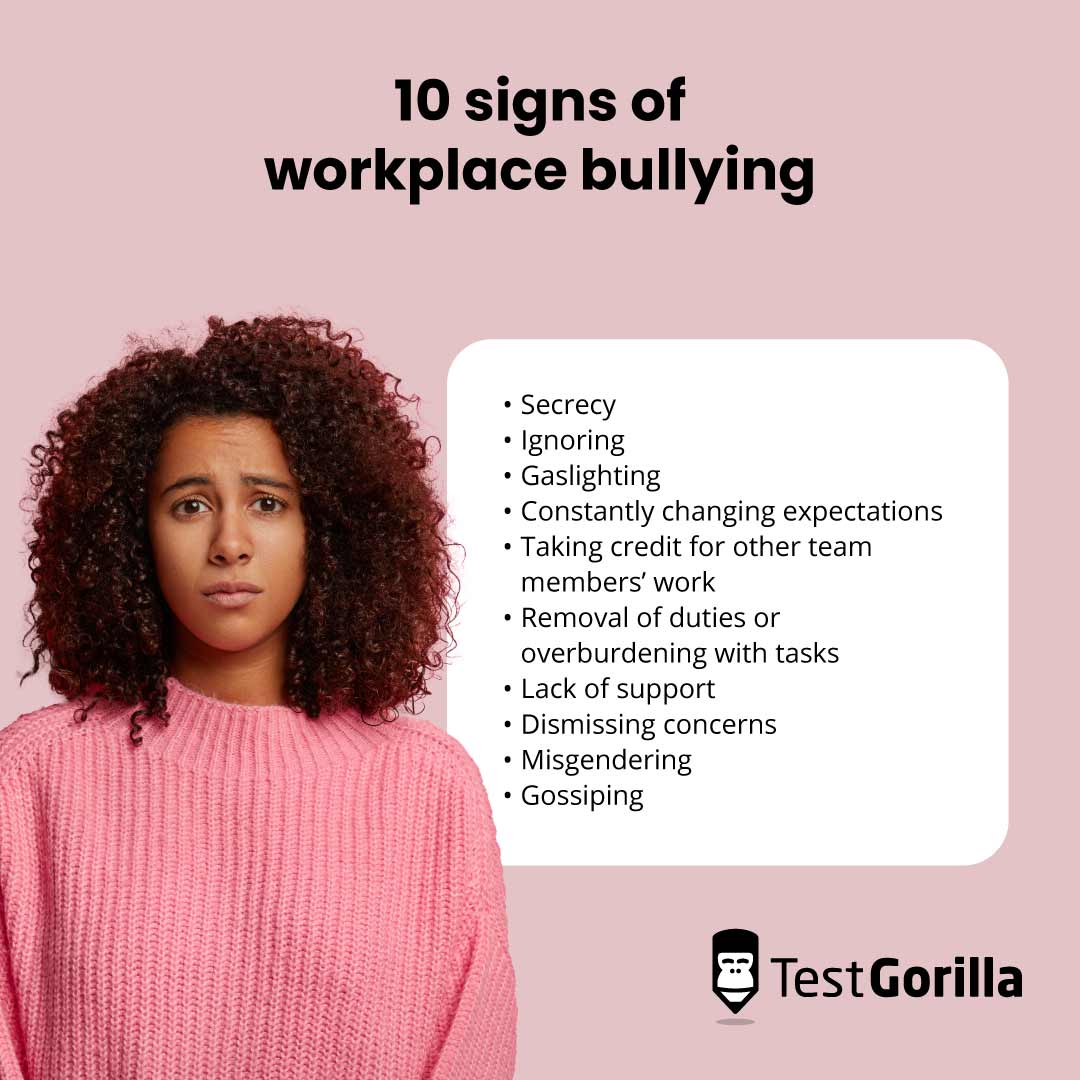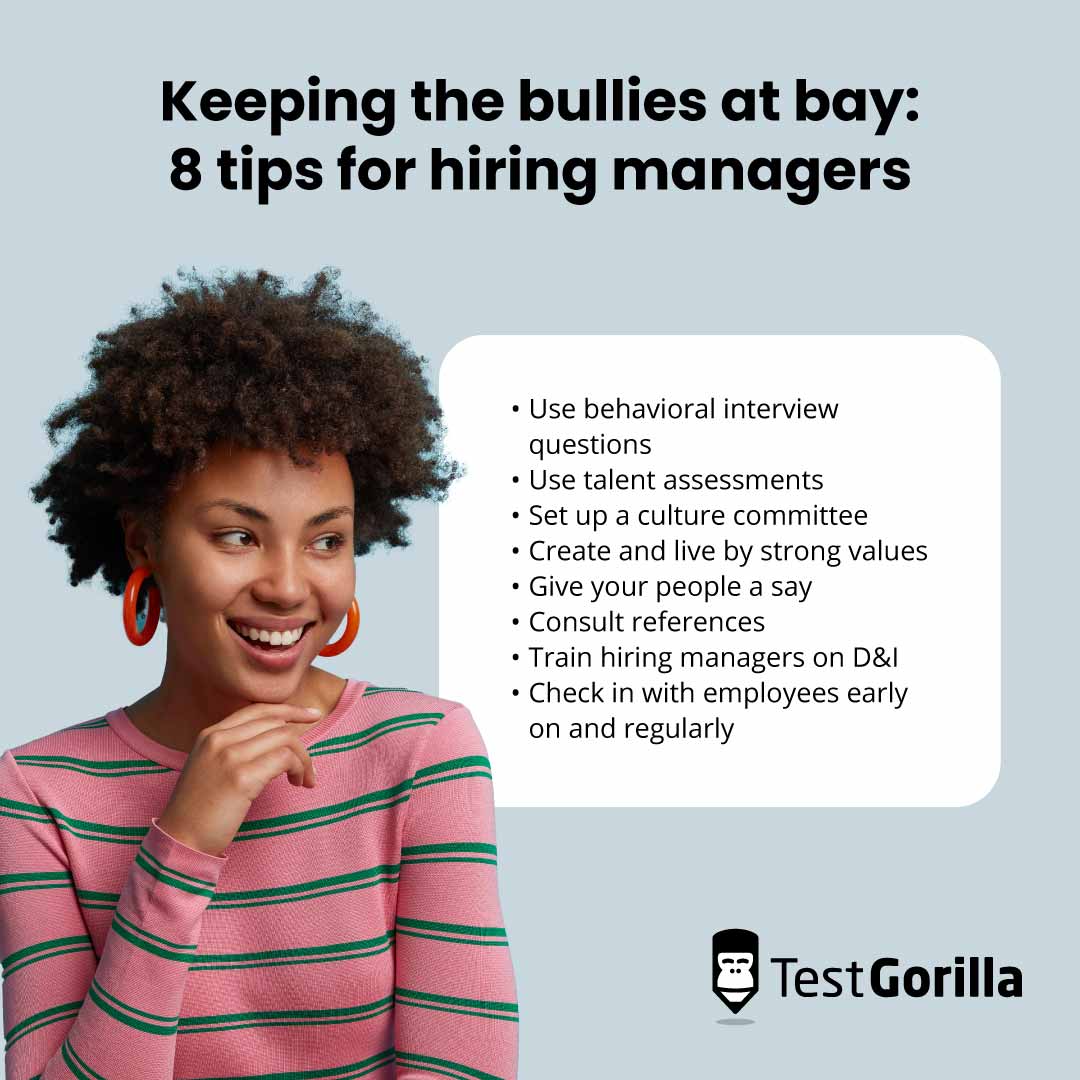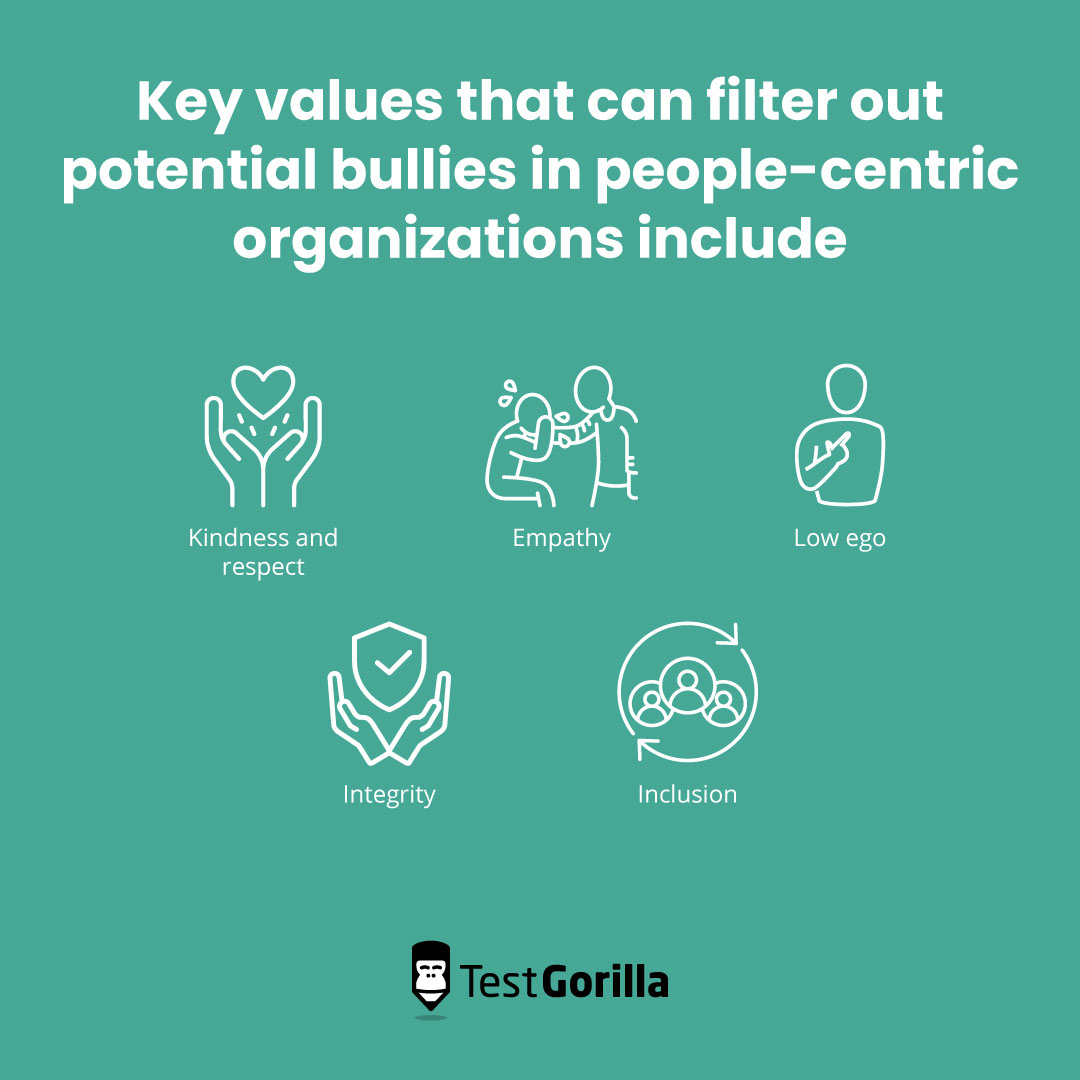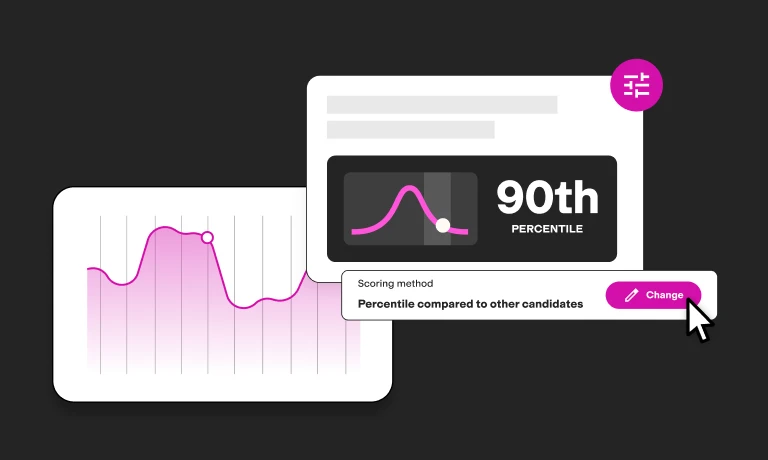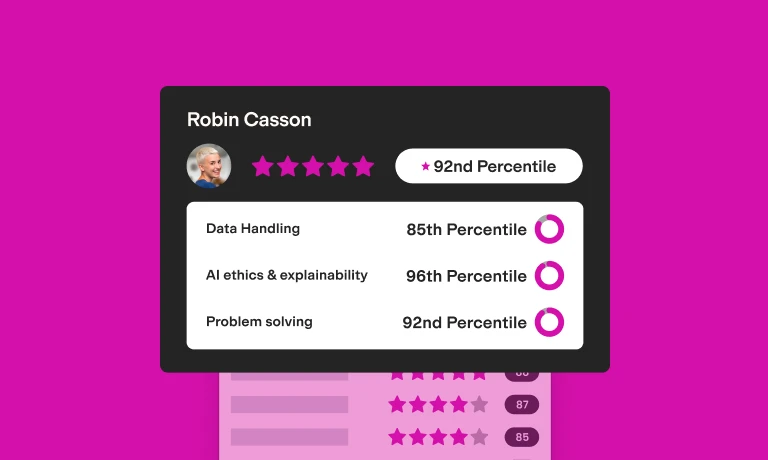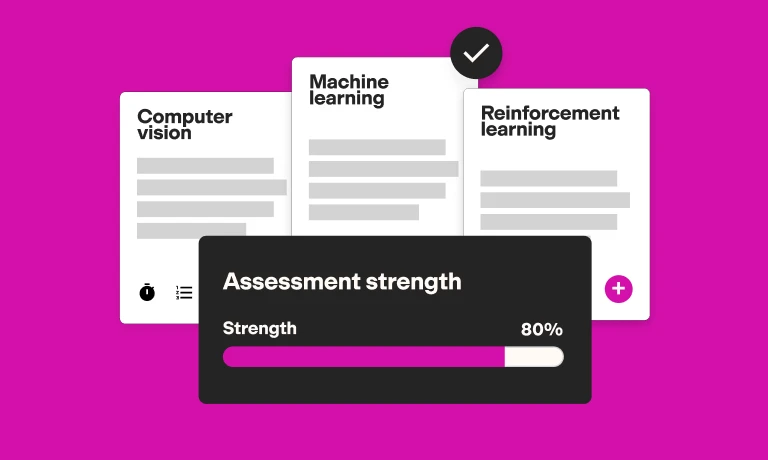Sometimes people leave their jobs for more pay, a new challenge, or a better work-life balance. At other times, there’s a bigger issue at play: a workplace bully and a toxic work environment.
In the current employment market, it might be tempting to hire anyone with the right skills who is willing and able to do the work. However, a hostile workplace negatively affects the long-term health of your organization and workers. Over time, it deteriorates their productivity, motivation, and happiness levels.
Creating a positive working environment and keeping bullies away is essential to retaining your talent and building an innovative and creative workforce that gives you a competitive edge.
In this piece, we’ll look at the best recruitment practices to avoid hiring bullies, like using personality and culture add assessments that filter out candidates with toxic tendencies.
Table of contents
The dark side of the office: What’s the cost of a toxic workplace?
Workplace bullying is the ongoing mistreatment of an individual and can come in various forms, including verbal abuse or offensive behaviors that are threatening, humiliating, or intimidating. Some signs of workplace bullying include:
Secrecy
Ignoring
Gaslighting
Constantly changing expectations
Taking credit for other team members’ work
Removal of duties or overburdening with tasks
Lack of support
Dismissing concerns
Misgendering
Gossiping
Almost one in three employees (30%) have been bullied at work.[1] This number rises to 43.2% for remote workers as hostile behaviors are harder to monitor and address in digital environments.
However, the negative effects of bullying reach far beyond those directly involved, affecting the mental health of witnesses and negatively impacting your business through:
High turnover rates. A toxic work culture is the biggest factor pushing employees out of the door. Compared to compensation, it’s 10.4 times more likely to contribute to attrition, where individuals voluntarily or involuntarily leave the company.
Lack of psychological safety. When people don’t feel like they can safely speak up, they’re less likely to freely express their opinions, be innovative and creative, and provide valuable feedback that could improve the company.
Decreased motivation and productivity. Bullying creates a hostile work environment that makes it harder for employees to stay engaged and feel passionate about their jobs. It also disrupts teamwork and isolates team members, which ultimately impacts productivity.
We’ve spoken to individuals worldwide about their experiences with workplace bullying, specifically when their bullies were their managers. One source, a sales manager in the trade sector, spoke about some demoralizing situations he went through.
“In all my years working at that company, I never felt safe. My manager would share instructions for a task, but when we followed it and presented her with the results, she would pretend she’d never said that. She would berate us, make us feel like children, and then take all my projects away. Sometimes, she would give us a month’s worth of work to do in one week. No one stuck around for long. Some people quit in their first month.”
Anonymous source
In addition to hurting employees’ mental health, bullying can also have adverse effects on their physical well-being.
“I was bullied by my manager for five years at my previous job. I thought I could stick it out. But towards the end, I was diagnosed with stress-induced Ménière’s disease and had to quit. [As a result,] I experienced severe hearing loss and ended up with a life-long disability.”
Anonymous source
Keeping the bullies at bay: 8 best practices for hiring managers
Workplace bullying relies heavily on power dynamics, as the bully often has a higher position, more influence, or more support than the victim. While coworkers can bully each other as well, most workplace bullying is top-down, with 65% of perpetrators being managers.[1]
That’s why some companies use a dark core personality test to identify how prone the candidates are to problematic behavior. However, we suggest a more comprehensive approach.
Here are some tips to nip the problem in the bud and avoid hiring bullies in the first place – specifically for leadership positions.
1. Use behavioral interview questions
The purpose of behavioral questions is to assess how a candidate has handled various work situations in the past and how they might behave in the future. They help you better understand their communication style, problem-solving skills, and teamwork abilities.
Kim Flanery-Rye, founder and principal DEI and culture practitioner at Inclusion Equals, says that these questions “get to the heart” of who your candidate is. Kim separates behavioral questioning into two categories, which go hand in hand:
How well candidates show up in difficult situations
How well they emotionally regulate in those instances
“A typical behavioral question might be ‘Can you describe a time when you encountered a stressful or difficult situation in the workplace?’ Then, you tap into their emotional regulation [skills] by asking a follow-up, like ‘How did you manage your emotions in that moment?’ Those kinds of questions add more nuance to behavioral questions.”
Kim Flanery-Rye, founder and principal DEI and culture practitioner at Inclusion Equals
The red flags show up if candidates:
Clam up
Don’t want to talk about difficult situations
Are struggling to come up with an answer
Get defensive or angry
Instead, someone with high levels of emotional intelligence will be honest about how they handled a difficult situation and what they learned from it. Even if they didn’t react well at the time, they can acknowledge it and hold themselves accountable.
Some other behavioral questions you can ask include:
What would you do if your report made a mistake that needed to be fixed ASAP?
How would you go about giving difficult feedback to someone on your team?
Was there a time when you had to read the room and adjust how you delivered something?
2. Use talent assessments
Talent assessments and personality tests can help assess how candidates behave in different situations, how they interact with others, and how they cope with stress and conflict. While these tests can’t fully predict whether someone will be a bully, they can help you identify some traits that might be associated with a risk of bullying, for example:
Low humility
Low levels of honesty
Low agreeableness
Poor impulse control
Poor stress tolerance
Low conscientiousness
Low emotional stability
High extroversion
Low open-mindedness [2]
Some talent assessments you can consider include:
Big 5 (OCEAN): This test evaluates five aspects of personality: openness, conscientiousness, extroversion, agreeableness, and emotional stability.
DISC: The DISC test classifies how we express our emotions into four types of behavior: dominance (D), influence (I), steadiness (S), and conscientiousness (C).
Enneagram: The Enneagram test plots nine distinct personalities on a diagram with nine points, revealing the fundamental beliefs and perspectives that each individual operates from.
16 types: The 16-type personality test, based on the work of Carl Jung, provides valuable insights into a candidate’s energy source, information processing style, decision-making approach, and preferred lifestyle.
Leadership & people management: This test helps you assess a candidate’s ability to lead others using their influence and guidance. The results show you which leaders will be best at supporting and developing others while helping your organization grow.
When you combine these tests with other methods, such as behavioral interviews, culture committees, and checking references, you get a clearer view of who you’re hiring.
Pro tip: Skills-based hiring gives you a data-backed, objective way to check for crucial qualities like leadership skills and culture add. It also lets you cast a wider net, attracting candidates with diverse backgrounds and experiences who might have been otherwise overlooked by traditional hiring practices.
3. Set up a culture committee
A culture committee is a diverse, cross-functional group of employees that accurately reflect your company’s culture in the recruitment process. This panel doesn’t test for the candidate’s skills and abilities, but how well they align with your organizational values and diversity and inclusion (D&I) commitments.
This is a useful method for spotting signs of microaggression and harmful behaviors that might fly under the radar of an interviewer with the same gender, race, or cultural background as the interviewee.
“I did a culture interview for a potential sales hire with my boss, who’s a man. The interviewee was also a man with a similar cultural and economic background as him, so they hit it off immediately. They even lived near each other so they bonded over the neighborhood dog park. But [the candidate] was totally dismissive of me and mansplained sales concepts to me the whole time. Thankfully, he didn’t get past the culture committee stage.” – Anonymous source
By sitting in on culture interviews, diverse employees can transform the process and share valuable insight on your potential hire. Taking multiple opinions into account also helps you mitigate the risk of any unconscious bias.
Pro tip: Give culture committee members access to tests and resources to help them identify their implicit biases and address them before interviews. Harvard’s Implicit Association Tests (IAT) is a good place to start. For more tips, check out our guide to minimizing unconscious bias and hiring discrimination.
4. Create and live by strong values
Strong organizational values are the guiding framework that helps you avoid bad hires and foster a positive work culture. By clearly communicating and reinforcing these values throughout the organization, you create a shared understanding of the behavior that’s expected and encouraged.
This can discourage bullies on a systemic level since they’re more likely to be held accountable by their peers and managers.
As a first step, solidify your company values before searching for them in potential employees. This helps you look for candidates from a wide range of backgrounds and ideologies, but with the same broad values as your organization. Then, clearly communicate those values and how you expect employees to live up to them across hiring stages and during onboarding.
Some key values that can filter out potential bullies in people-centric organizations include:
Kindness and respect
Empathy
Low ego
Integrity
Inclusion
Consider implementing a culture add test to objectively evaluate how a candidate’s values align with yours and what they can add to them.
Finally, even if a bully does get past the hiring stage, you can still stop them in their tracks by fostering an environment that’s anti-bullying. Kim recommends including values training right at the onboarding stage.
“Onboarding is another opportunity to showcase your company, the way that you live your values, and how you bring people forward,” she says. “You can have a team meeting…as part of your onboarding…and [talk] about your values, your mission, and share examples of how they show up… [Eventually,] either the bullies will [leave on their own] or they’ll [end up] in a misconduct scenario and be forced out.”
5. Give your people a say
A collaborative approach gives your team members the opportunity to meet and interview their potential coworker or manager. It also ensures that you assess candidates on more than their technical skills and qualifications – namely their compatibility with the team and ability to create a positive workplace.
Team members can validate your choice or flag any bullying tendencies or behaviors that are inconsistent with the group’s values. After all, they have first-hand experience with team dynamics and desired leadership qualities.
Team involvement also creates a sense of ownership and empowerment which can help build trust and strengthen relationships within the team. It sends a clear message that their opinions matter and that your organization prioritizes their well-being and happiness.
Pro tip: Make sure there is structure to the team interview and that the criteria and questions are standardized. This way, employees are less likely to make arbitrary, subjective decisions. For more ideas, check out these 100 interview questions to assess candidates and review their skills.
6. Consult references
References offer more insights into a candidate’s past behavior, values, and interpersonal skills. They act as a reality check, giving you first-hand accounts that go beyond the polished facade of an interview.
They can also help uncover potential red flags or patterns of abusive behavior that might otherwise go unnoticed. By reaching out to references, you can verify the candidate’s claims and assess how well they interact with others and add to your team. For example, you can ask about their interpersonal skills and how they interacted with their reports or colleagues.
You can also reach out to references from a past company that a candidate has worked for. A bully’s current organization might give them a positive reference to get them out the door. But a previous one won’t have anything to lose by giving you an honest answer.
7. Train hiring managers on D&I
Members of marginalized communities – like Black, indigenous, people of color (BIPOC), LGTBQ+ workers, people with disabilities, and women, are more vulnerable to bullying at work. Forty-one percent of black and minority ethnic workers in the UK have faced racism at work in the last five years.
The number rises to more than half (52%) of those aged 25 to 34 years old, and nearly 3 in 5 (58%) of those aged between 18 and 24 years old.
Training hiring managers and leaders on D&I gives them the necessary knowledge and skills to create an inclusive and respectful work environment. If bullying does happen, managers who are trained in D&I can take a fair course of action and better support the victim.
D&I training also sheds light on any unconscious biases they might have, which makes them less likely to favor people of similar gender, race, or cultural background.
Pro tip: Skills-based hiring helps your company recruit HR professionals and leaders from a wide range of backgrounds. Having more diverse individuals in leadership positions positively impacts how other people of color or members of marginalized groups are treated at work.
For more tips on D&I hiring, check out our seven best practices to make your company more diverse and inclusive.
8. Check in with employees early on and regularly
Kim notes that while 30-day, 90-day, and 6-month check-ins are necessary, hiring managers and HR professionals should check in with their employees way earlier.
“Within two weeks, you’ll want to get feedback from your employees and the new person on how things are going… Because most people and companies will know within two weeks if it was the right hire or not,” she says.
“What happens is that they drag on that process because they’re like ‘maybe we can help them, maybe I’m wrong…’ But most people know [within that time.] Although there is a bit of a lag now in a virtual environment.” In a remote workplace, it’s particularly important to keep an eye out for warning signs since it’s not always obvious who the bullies are.
With regular check-ins, you’ll have more opportunities to notice hostile behaviors and microaggressions and address them appropriately.
The best insights on HR and recruitment, delivered to your inbox.
Biweekly updates. No spam. Unsubscribe any time.
The key to building a strong team: Avoid hiring a workplace bully
A toxic and hostile company culture harms both your organization and people in the short and long term. For example, a harmful manager or team member worsens retention rates by creating an environment where individuals don’t feel safe and motivated.
Workplace bullying also harms employees’ mental and physical health, increases stress levels, and stifles innovation and creativity. When your people don’t feel safe and motivated at work, their productivity levels take a hit and they’re less likely to stay at your company for long.
By prioritizing an inclusive and respectful work culture, you can build resilient, happy, and productive teams. One way to do that is by implementing strategies at the hiring stage that keep workplace bullies out of your organization.
To do this, use skills-based hiring and personality assessments, set up a culture committee, and give your people a say in the hiring process.
Successfully setting up these recruitment methods in your organization can help you attract the right talent, retain your best people, and enhance your ROI on hiring. All of this helps you create a better place to work and gives your company and teams a competitive edge.
Want to build happier, longer-lasting teams?
Learn how skills-based hiring gives you a more objective way to hire diverse talent that adds to your culture. Download the 2022 State of Skills-Based Hiring report.
Sources
“2021 WBI U.S. Workplace Bullying Survey.” Workplace Bullying Institute. Accessed May 28, 2023. https://workplacebullying.org/2021-wbi-survey/
“The relationship between personality and bullying among primary school children: the mediation role of trait emotion intelligence and empathy.” (2023). International Journal of Clinical and Health Psychology. Accessed May 28, 2023. https://www.sciencedirect.com/science/article/pii/S1697260022000679
Related posts
You've scrolled this far
Why not try TestGorilla for free, and see what happens when you put skills first.


